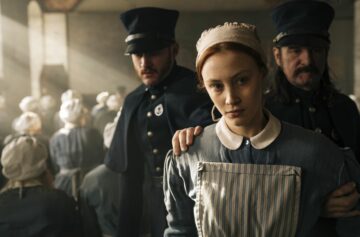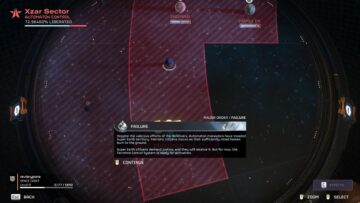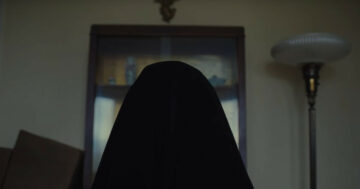[Ed. note: This post contains spoilers for Fallout season 1, as well as information from the Fallout games.]
The Vault systems in the Fallout franchise are meant to be a utopia, a shelter away from the harsh apocalyptic Wasteland and nuclear fire.
Of course, nothing is ever as it seems, and a little bit of digging (Lucy’s journey in Fallout season 1 or playing to the end of Fallout 2) reveals that the Vault systems are actually a way to experiment on survivors. Some of the premises are so wild or impractical that it doesn’t seem like an experiment at all, and many failed spectacularly. (According to series creator Tim Cain, the purpose was to test humanity’s ability to travel through space, but this isn’t in any of the games so far.)
There are two experiments in the Prime Video show that we get to see: Vault 4 and the combined network of Vaults 31, 32, and 33. Something like Vault 4 is relatively straightforward: a society ruled by scientists. Unfortunately, the scientists’ experiments got out of hand, creating the monstrous gulpers and requiring a total restructuring of their society.
Vaults 31, 32, and 33 are a little more complex. These interlinked Vaults rely on each other, with the members of 33 and 32 arranging marriages in order to diversify their populations. Early on, it appears that 32 fell to raiders. However, Norm and Chet soon find that the inhabitants of 32 died long before raiders ever arrived due to a terrible famine. As for Vault 31, we learn that Vault-Tec executives are frozen in here, and thawed whenever a new Overseer must be installed.
If you’re curious as to the other Vaults scattered across Fallout’s vast canon, here is a list of the monstrous experiments that Vault-Tec carried out after the apocalypse.
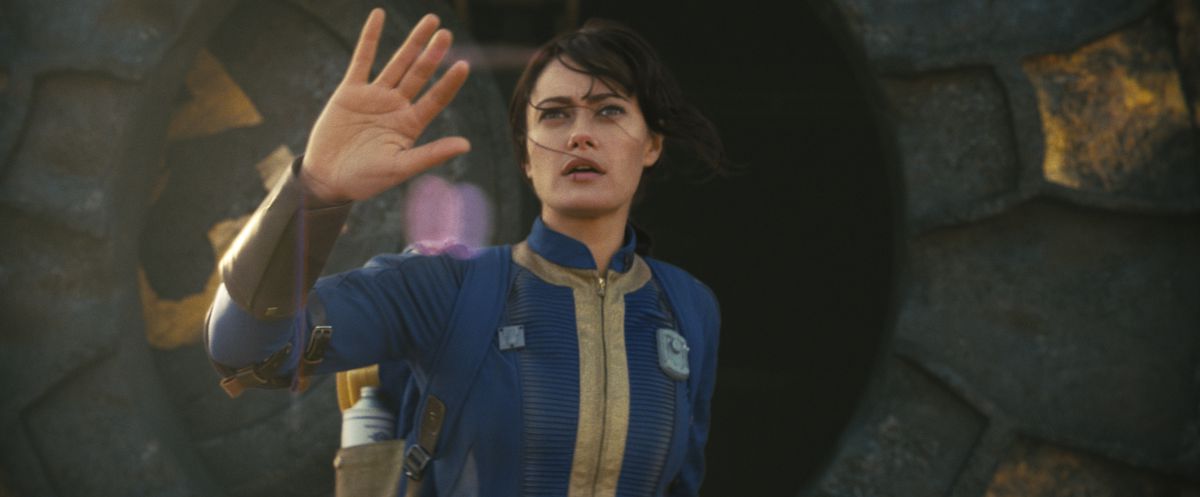
Image: Prime Video
Vault 4: Those poor, unfortunate scientists. Now populated with the survivors, combined with refugees from Shady Sands. Chris Parnell plays the good-spirited Overseer, with a slightly strange single eye.
Vault 8: A control Vault, which means there was no active experiment. After 10 years, the Vault opened and used its Garden of Eden Creation Kit to found the large and successful Vault City.
Vault 11: This Vault had a psychology test in which the occupants had to vote for one human sacrifice each year or else lose all life support. The cruel conclusion of the experiment is that if the Vault Dwellers did refuse to sacrifice one of their own, the Vault would open and allow them to leave unharmed. Unsurprisingly, this is not what happened, and the results were tragic.
Vault 12: What happens if the Vault door doesn’t seal quite right, and radiation filters in? The answer is Necropolis, a community of Ghouls.
Vault 13: The home of the original Fallout’s protagonist. Vault 13 was meant to stay closed for 200 years, but a faulty water chip led to one of their own trekking out into the world in search of a solution.
Vault 15: This Vault remained closed for 50 years, and the population was drawn from people of different walks of life and ideologies. Some of the population of this Vault went on to found Shady Sands, and eventually the New California Republic.
Vault 19: This Vault housed two societies, red and blue, each with one Overseer. What the occupants didn’t know is that they were flooded with subliminal messages to pit them against each other, which eventually culminated in civil war.
Vault 21: What if all conflict had to be resolved by gambling? The Vault would later be acquired by Mr. House and turned into a pleasant novelty hotel for tourists to New Vegas.
Vault 22: At first glance, it’s a botanist’s dream, in which the experiment is to develop plant life in the Vault with the help of sophisticated and advanced equipment. A parasitic fungus turned on the researchers and consumed the Vault.
Vault 27: Filled with double the sustainable population.
Vault 29: The age cap for occupants was 15 years old.
Vaults 31, 32, and 33: Lucy’s Vault (33), and the site of a lot of intrigue in season 1 of Fallout. The gist is that these three Vaults are interconnected, and 32 and 33 often exchange inhabitants to diversify the gene pool and create new generations. Things go horribly awry when the population of 32 is replaced with raiders, who attack — thus kicking off the events of the show. Lucy, and the other Vault inhabitants, do not realize that there is an experiment; they think this is the good life. And, as mentioned above, Vault 31 is there to house frozen Vault-Tec staff to bring into Vaults 32 and 33 as necessary.
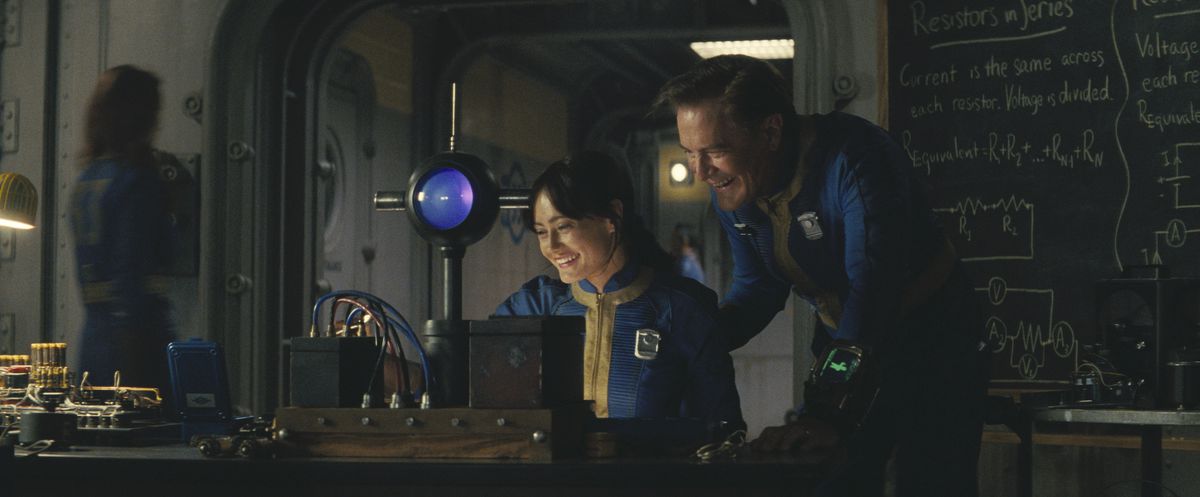
Vault 34: The armory was stuffed with weapons, and there was no proper locking mechanism on the door. Eventually failed due to a riot and reactor damage.
Vault 36: Instead of proper food, the occupants were fed only a thin, watery gruel.
Vault 42: No lightbulbs of more than 40 watts were provided, which likely meant this Vault had a dim future.
Vault 51: This Vault was meant to test the limits of human tribalism, with an experimental AI running the show and selecting the Overseer. Perhaps unsurprisingly, the AI eventually killed the Vault’s occupants instead of rigorously testing them.
Vault 53: The equipment was designed to constantly suffer minor but repairable failures in order to study the effect stress had on the Vault’s inhabitants.
Vaults 55 and 56: In Vault 55, all of the entertainment tapes were removed. In Vault 56, they were all removed except for one really bad comedian. Truly, a terrifying fate.
Vaults 68 and 69: In Vault 68, the population only contained one woman. This ratio was flipped for Vault 69. This is one of the Vaults that feels especially disinterested in scientific curiosity in favor of cruelty; it’s hard to see any situation in which Vault 68 prospers.
Vault 70: The Vault stopped producing jumpsuits after six months.
Vault 75: This experiment was focused on breeding the perfect human, with failures being incinerated and successes joining the scientific staff to try and improve the process for the next generation.
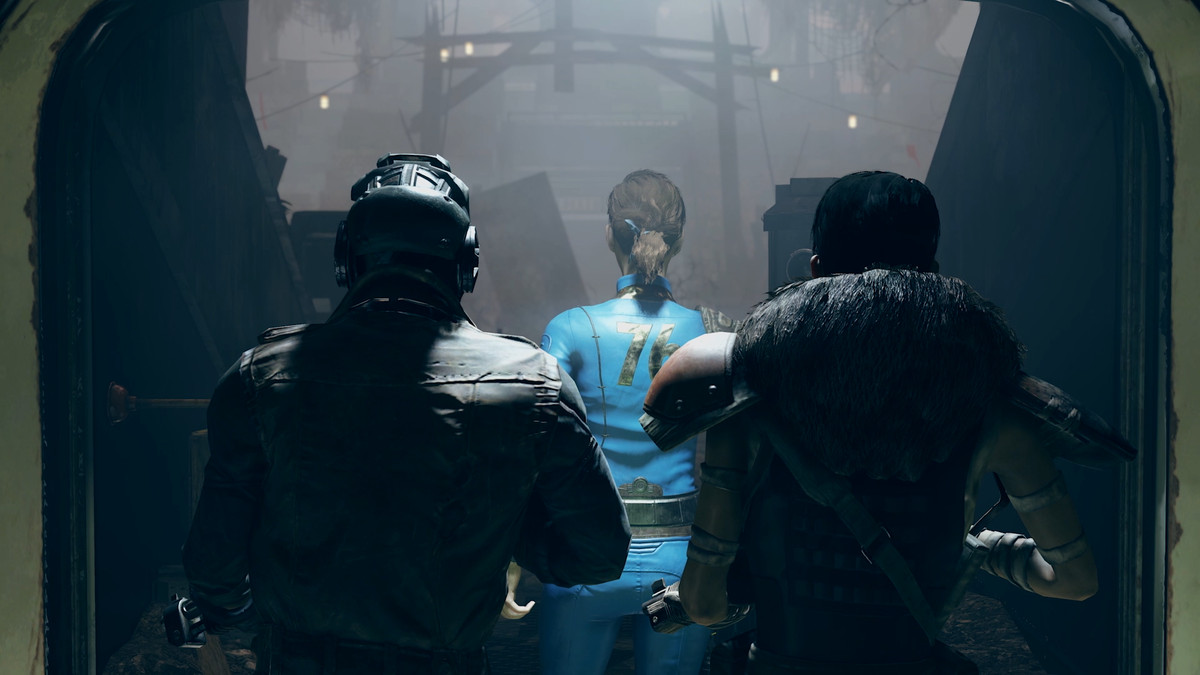
Vault 76: A control Vault, and the one from which all Fallout 76 players emerge.
Vault 81: A Vault focused on researching diseases and antibodies. Similar to Vault 75, the residents were openly used as guinea pigs.
Vault 87: Experimenting on humans using the Forced Evolutionary Virus, which leads to super mutants appearing in the Capital Wasteland of Fallout 3.
Vault 92: This Vault was filled with talented musicians, and then they were exposed to white noise that subliminally implanted combat suggestions. The musicians all lost their minds and descended into murder and mayhem.
Vault 94: Filled to the brim with pacifists and chill folk, this Vault was meant to prove the innate goodness of humanity. One year after the Great War, the doors opened, and raiders promptly blew the entire thing up.
Vault 95: Every occupant was struggling with an addiction to drugs, and this Vault was designed to study their withdrawal, and then reexpose them to an endless amount of chems. The Vault collapsed shortly afterward.
Vault 96: The Vault was filled with embryos that would be artificially raised to adulthood and then released into the Wasteland with robot companions and protectors.
Vault 101: A Vault designed to remain in total isolation from the outside world — until the events of Fallout 3 kick off, and the Lone Wanderer takes off in search of their father, James. It’s a fun parallel with Lucy and her search for her father.

Vault 106: Psychoactive drugs were released into the air after the door was sealed. We can only hope the inhabitants had good trips.
Vault 108: The Vault was left without reliable leadership, and during its isolation from the world, the survivors accidentally cloned a whole host of Gary. These clones stalk the Vault, only able to say one word: “Gary.”
Vault 111: The survivors in this Vault were cryogenically frozen, with staff, security, and scientists making sure their pods remained operational. The Vault failed in 2078, and 210 years later, the Sole Survivor emerges from their pod in order to find their son, Shaun.
Vault 112: Dr. Stanislaus Braun took a much smaller population into this Vault and hooked them into virtual reality pods, where they could experience a true utopia. Braun eventually became bored, and the experiment turned much more sinister as he hunted down each survivor in their virtual reality, killed them, wiped their memories, and began anew.
Vault 114: Members of higher social classes were welcomed into this Vault, only to find it overcrowded and minimally equipped. The Overseer was selected outside of the usual population, with the intent of finding the most ornery and anti-authority candidate possible.
Vault 118: This Vault was meant to be filled with the ultra-wealthy and the working poor. However, before the working poor could arrive, funding ran out. The rich inhabitants would remove their brains, implanting them in robots, in order to survive forever.
- SEO Powered Content & PR Distribution. Get Amplified Today.
- PlatoData.Network Vertical Generative Ai. Empower Yourself. Access Here.
- PlatoAiStream. Web3 Intelligence. Knowledge Amplified. Access Here.
- PlatoESG. Carbon, CleanTech, Energy, Environment, Solar, Waste Management. Access Here.
- PlatoHealth. Biotech and Clinical Trials Intelligence. Access Here.
- Source: https://www.polygon.com/24128668/vault-tec-experiments-explainer-lore-prime
- :is
- :not
- :where
- $UP
- 1
- 10
- 101
- 11
- 114
- 118
- 12
- 13
- 15 years
- 15%
- 19
- 200
- 21
- 210
- 22
- 27
- 29
- 31
- 32
- 33
- 34
- 36
- 4
- 40
- 42
- 50
- 50 Years
- 51
- 55
- 70
- 75
- 8
- 87
- a
- ability
- Able
- above
- accidentally
- According
- acquired
- across
- active
- actually
- addiction
- adulthood
- advanced
- After
- against
- age
- AI
- AIR
- All
- allow
- amount
- an
- and
- answer
- Antibodies
- any
- appearing
- appears
- ARE
- arrive
- arrived
- AS
- At
- attack
- away
- Bad
- BE
- became
- before
- began
- behind
- being
- Bit
- Blue
- Bored
- brains
- bring
- but
- by
- california
- CAN
- candidate
- cap
- capital
- carried
- character
- chip
- Chris
- City
- civil
- classes
- closed
- collapsed
- combat
- combined
- comedian
- community
- companions
- complex
- conclusion
- conflict
- constantly
- consumed
- contained
- contains
- control
- could
- course
- create
- Creating
- creation
- creator
- curiosity
- curious
- Dad
- damage
- Days
- designed
- develop
- DID
- died
- different
- diseases
- diversify
- do
- Doesn’t
- Door
- doors
- double
- down
- drawn
- dream
- Drugs
- due
- during
- each
- Early
- eden
- effect
- else
- emerge
- emerges
- end
- Endless
- Entertainment
- Entire
- equipment
- equipped
- especially
- Ether (ETH)
- Even
- events
- eventually
- EVER
- Every
- Except
- exchange
- executives
- experience
- experiment
- experimental
- experiments
- exposed
- eye
- Failed
- failures
- fallout
- far
- fate
- faulty
- favor
- Fed
- feels
- Figures
- filled
- filters
- Find
- finding
- Fire
- First
- flooded
- focused
- food
- For
- forced
- forever
- found
- from
- frozen
- fun
- funding
- future
- Gambling
- game
- Games
- Garden
- Gary
- generation
- generations
- get
- Glance
- Go
- good
- got
- great
- had
- hand
- happened
- happens
- Hard
- Have
- he
- help
- her
- here
- higher
- holding
- Home
- hope
- horribly
- host
- hotel
- House
- However
- HTTPS
- human
- Humanity
- Humans
- ideologies
- if
- impractical
- improve
- in
- incinerated
- indicates
- information
- inhabitants
- innate
- installed
- instead
- intent
- interconnected
- into
- isolation
- IT
- ITS
- james
- joining
- journey
- jpg
- kick
- kit
- Know
- kyle
- large
- later
- Leadership
- Leads
- LEARN
- Leave
- Led
- left
- Life
- like
- likely
- limits
- List
- little
- locking
- Long
- looking
- lose
- lost
- Lot
- Making
- means
- meant
- mechanism
- member
- Members
- Memories
- mentioned
- messages
- minds
- minor
- months
- more
- most
- mr
- much
- murder
- musicians
- must
- necessary
- network
- New
- next
- no
- Noise
- note
- nothing
- novelty
- now
- nuclear
- of
- off
- often
- Old
- on
- ONE
- only
- open
- opened
- openly
- operational
- or
- order
- original
- Other
- out
- outside
- over
- own
- Parallel
- People
- perfect
- perhaps
- PIT
- plant
- plato
- Plato Data Intelligence
- PlatoData
- players
- playing
- plays
- pods
- Polygon
- pool
- poor
- populated
- population
- populations
- possible
- Post
- Prime
- process
- producing
- promptly
- proper
- protagonist
- Prove
- provided
- Psychology
- purpose
- quite
- Radiation
- raised
- ran
- ratio
- reactor
- Reality
- realize
- really
- Red
- refugees
- relatively
- released
- reliable
- rely
- remain
- remained
- remove
- Removed
- replaced
- Republic
- researchers
- residents
- resolved
- restructuring
- Results
- Reveals
- Rich
- right
- Riot
- robot
- robots
- roughly
- ruled
- running
- sacrifice
- say
- scattered
- Science
- scientific
- scientists
- Search
- Season
- Season 1
- security
- see
- seem
- seems
- seen
- selected
- selecting
- Series
- shady
- she
- Shelter
- Shortly
- show
- similar
- single
- site
- situation
- SIX
- Six months
- slightly
- smaller
- So
- so Far
- Social
- Society
- solution
- some
- something
- son
- Soon
- sophisticated
- Staff
- stay
- Still
- stopped
- straightforward
- strange
- stress
- Struggling
- Study
- successes
- successful
- suffer
- Super
- support
- sure
- survive
- survivor
- sustainable
- Systems
- takes
- talented
- terrible
- terrifying
- test
- Testing
- than
- that
- The
- The Capital
- The Vault
- the world
- their
- Them
- then
- There.
- These
- they
- thin
- thing
- things
- Think
- this
- those
- three
- Through
- Thus
- Tim
- to
- took
- Total
- travel
- true
- truly
- try
- Turned
- two
- unfortunate
- unfortunately
- until
- used
- using
- usual
- Utopia
- Vast
- Vault
- vaults
- VEGAS
- Video
- Virtual
- Virtual reality
- virus
- Vote
- walks
- wanderer
- war
- was
- Water
- watts
- Way..
- we
- Weapons
- webp
- welcomed
- WELL
- went
- were
- What
- when
- whenever
- which
- white
- WHO
- whole
- Wild
- with
- withdrawal
- without
- woman
- Word
- working
- world
- would
- year
- year after
- years
- zephyrnet


